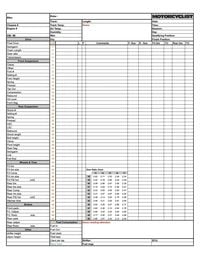That Official Team Minion with the clipboard grilling Valentino Rossi, Ben Spies or Ari Henning between practice sessions isn't taking lunch orders. He's finding out what's working where to help Vale, Elbowz or that other guy go faster next time. Information is power, or in this case, time. And time, as they say, is money. You may not have a team, never mind a team minion, at the track. But you should have a clipboard with some sort of standard data sheet clipped to it. Those who do not remember past set-up sins are doomed to repeat them. A binder full of data sheets can be as valuable as fuel and fresh tires, especially when you're learning a new track or some new brand of tire.
Resident wrist Barry Burke developed the sheet we use, calling on the expertise of former Vance & Hines Superbike crew chief Jim Leonard, who has run the show for the likes of Eddie Lawson, Ben Bostrom and Anthony Gobert. Burke and Leonard like to track more facts and figures than the average Group C newbie, but everybody starts with the basics: tire type, starting pressure, suspension set-up and track notes. The owner's manual can get you in the ballpark if you're starting from scratch, and tire-service personnel can be a wealth of information if you're using race rubber. No matter who you are or how fast you're going out there, checking all the appropriate boxes on a track data sheet to make sure all systems are go can save time, trouble or even an ambulance ride. Better to find out your heavy-handed cousin dialed another 12 clicks into the steering damper while there's still time to do something about it!
Once things get rolling, the data sheet can really help your riding. Writing down which corners are giving you problems goes a long way toward coming up with the right solutions. Sometimes just thinking through a particular section and putting pencil to paper will shave off a second or three. Just hold off on making wholesale suspension changes unless the bike is doing something genuinely evil. Then start with small ones, one at a time. A half-dozen tweaks between sessions pushes the potentially difficult process of deciphering which one did what six steps closer to impossible. Lap times from the transponders provided by many track-day organizers help substantiate traditional seat-of-the-pants readings, so use them. And archived data sheets are an invaluable tool for turning the corners you hate into the corners you love.
Some of the categories on our data sheet are more useful for an expert coming to terms with the extra variables on a racebike than a track-day neophyte exploring uncharted territory. If this whole shtick looks too complicated, start with the basics and work your way up. Record as much information as you can. Something that seems arcane now just might come in handy in six months. Knowledge is power, remember?


/cloudfront-us-east-1.images.arcpublishing.com/octane/7OWQWAWJBFCGTAYQWBMWGNMNB4.jpg)
/cloudfront-us-east-1.images.arcpublishing.com/octane/4G5XKCDIHRCGRHVF7OPORG7ZX4.jpg)
/cloudfront-us-east-1.images.arcpublishing.com/octane/D2BDYKKNZ5GRHGDMI4PZTGRMME.jpg)

/cloudfront-us-east-1.images.arcpublishing.com/octane/UAY4WSZPOFDQRP4MCEXAKDFQOQ.jpg)

/cloudfront-us-east-1.images.arcpublishing.com/octane/X5CE3KSJHZHM5CUFGPZ7U26WB4.jpg)
/cloudfront-us-east-1.images.arcpublishing.com/octane/COWLTPGFAFGDDGJCTENYMA4VJM.jpg)
/cloudfront-us-east-1.images.arcpublishing.com/octane/H3PKUGPSUJFTND4RFPSI4OIDCE.jpg)
/cloudfront-us-east-1.images.arcpublishing.com/octane/UHGQA3MQDFCA3HLBWF7S76WH6Y.jpg)
/cloudfront-us-east-1.images.arcpublishing.com/octane/Q5EORCSTNFAVBJC4IYUHIKJTXQ.jpg)
/cloudfront-us-east-1.images.arcpublishing.com/octane/XIJ5FUFSP5A3NL7MOVZGJXAHC4.jpg)
/cloudfront-us-east-1.images.arcpublishing.com/octane/V5NZN3CGS5B5PPYFYJHIPAU5S4.jpg)
/cloudfront-us-east-1.images.arcpublishing.com/octane/CZE6ONOBU5E7HPIEEADU376C4M.jpg)
/cloudfront-us-east-1.images.arcpublishing.com/octane/UT4KL3SIYJBSPNHWJXTBE6MTGE.jpg)
/cloudfront-us-east-1.images.arcpublishing.com/octane/Q3UOIDZ22ZEVDBZUWGJXIMGJKI.jpg)
/cloudfront-us-east-1.images.arcpublishing.com/octane/YQM66WXZV5AAXNNOIUVOGVXZMY.jpg)
/cloudfront-us-east-1.images.arcpublishing.com/octane/J47NFTXNLFFGHELHZCUD2LCITA.jpg)
/cloudfront-us-east-1.images.arcpublishing.com/octane/NXPQBTLX3NCILKQ2GCFJYNIDEM.jpg)
/cloudfront-us-east-1.images.arcpublishing.com/octane/6U7NJLAYMRBZTIGNKWIA5OK2FQ.jpg)
/cloudfront-us-east-1.images.arcpublishing.com/octane/IYTZQWUROVC25IMTDEWUDQ5IQE.jpg)
/cloudfront-us-east-1.images.arcpublishing.com/octane/YJODDXEL2ZB5TENKPPN4BEYJAE.jpg)
/cloudfront-us-east-1.images.arcpublishing.com/octane/QEQQUZYNJFAIJB4DZFVFSNTCQ4.jpg)
/cloudfront-us-east-1.images.arcpublishing.com/octane/F4EEHDT3UZFKPLKVGDWMMPFEQE.jpg)